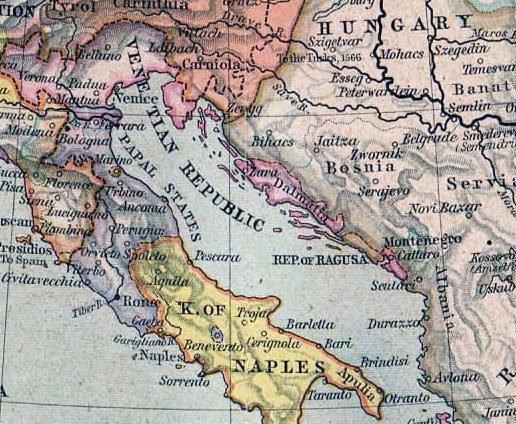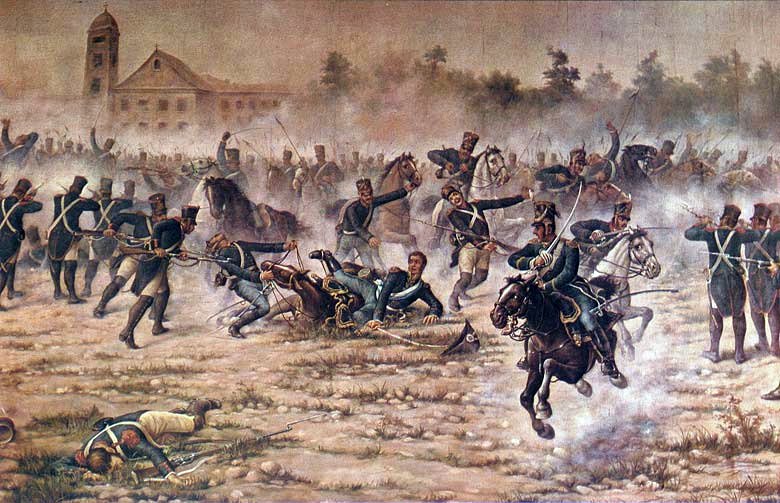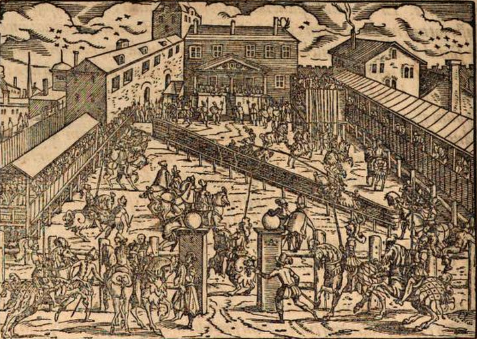|
Giovanni De Rubertis
Giovanni de Rubertis (25 December 1813 – 20 April 1889) was an Italian poet and translator of the Molise Slavs. Born in Acquaviva Collecroce (''Kruč''), he was the principal of the Casacalenda gymnasium. He proved key for the preservation of national consciousness and identity among the Serbs in Molise. He was a great friend with Medo Pucić, whose lyrics were translated into Italian. During his research on the Serbs in the south of Italy, Risto Kovačić visited De Rubertis in 1884. From January 1885 he became a correspondent member of the Serbian Learning Society. According to Graziadio Isaia Ascoli, De Rubertis considered the Schiavoni (Slavs) or Dalmati (Dalmatians) of Molise as Serbs that were brought there by Skanderbeg during his Italian expedition in 1460—1462 along with the Albanians. He died in Acquaviva Collecroce. See also * Molise Croatian dialect * Serb-Catholic movement in Dubrovnik The Serb-Catholic movement in Dubrovnik ( sh-Cyrl-Latn, separator=" / ... [...More Info...] [...Related Items...] OR: [Wikipedia] [Google] [Baidu] |
Acquaviva Collecroce
Acquaviva Collecroce (also called ''Živavoda Kruč'' or, usually, just ''Kruč'') is a small town and ''comune'' in the province of Campobasso, in the Molise region of southern Italy, between the Biferno and Trigno rivers. Like the smaller towns of Montemitro and San Felice del Molise, Acquaviva Collecroce is home to a community of Molisian Croats, most of whom speak a particular Croatian dialect (known as simply ''na-našo'' or ''naš jezik'', meaning "our language") as well as Italian. There are differences in the dialects of the three towns, but they all descend from the Shtokavian- Ikavian dialect of Dalmatia. The language is considered an endangered diaspora language. Acquaviva is known for the cultivation of small, dark, zerniza figs, as well as fennel and white celery. History In the 12th century, Acquaviva was a base for the Knights of Malta. Though there is evidence of an earlier Slavic settlement in 1297, it is believed that the current inhabitants are not ... [...More Info...] [...Related Items...] OR: [Wikipedia] [Google] [Baidu] |
Schiavone
Schiavone (; feminine ''Schiavona'', plural ''Schiavoni'') is an Italian ethnonym literally meaning " Slavs" in Old Venetian: originally, this term indicated origins in the lands of Dalmatia and Istria (in present-day Slovenia and Croatia), when under the rule of the Republic of Venice. Today it is an Italian surname. History The importance of Schiavoni's role in the Venetian Republic is best shown by the name of one of the main streets in Venice, Riva degli Schiavoni, just in front of the Doge Palace and San Marco Square. A number of artists who worked in Italy who were of Slavic descent were nicknamed ''Schiavone'' by their origin: most famous among them are Giulio Clovio, Francesco Laurana, and Luciano Laurana. Schiavone was also a designation of the Oltremarini, a military unit of the same descent in the Venetian Navy. The basket-hilted sword schiavona was also named after the Schiavone. Surname In Italy, the surname Schiavone mostly occurs in the southernmost region ... [...More Info...] [...Related Items...] OR: [Wikipedia] [Google] [Baidu] |
1813 Births
Events January–March * January 18–January 23 – War of 1812: The Battle of Frenchtown is fought in modern-day Monroe, Michigan between the United States and a British and Native American alliance. * January 24 – The Philharmonic Society (later the Royal Philharmonic Society) is founded in London. * January 28 – Jane Austen's ''Pride and Prejudice'' is published anonymously in London. * January 31 – The Assembly of the Year XIII is inaugurated in Buenos Aires. * February – War of 1812 in North America: General William Henry Harrison sends out an expedition to burn the British vessels at Fort Malden by going across Lake Erie via the Bass Islands in sleighs, but the ice is not hard enough, and the expedition returns. * February 3 – Argentine War of Independence: José de San Martín and his Regiment of Mounted Grenadiers gain a largely symbolic victory against a Spanish royalist army in the Battle of San Lorenzo. * Febru ... [...More Info...] [...Related Items...] OR: [Wikipedia] [Google] [Baidu] |
Croatian Biographical Lexicon
''Croatian Biographical Lexicon'' ( hr, Hrvatski biografski leksikon) is a multi-volume biographical and bibliographical encyclopedia in Croatian, published by the Miroslav Krleža Institute of Lexicography. It contains biographies of prominent Croats, as well as foreigners who participated in Croatian public life and have left their mark on the history of Croatia. The project was launched in the second half of the 1970s. Seven volumes have been published so far with a total of 10,218 articles (3,524 illustrations). The Editor-in-Chief of the first volume was Nikica Kolumbić Nikica Kolumbić (6 October 1930 - 1 March 2009) was Croatian historian and lexicographer. He was born in Zagreb. He graduated Croatian studies at the Faculty of Philosophy in Zagreb in 1955, receiving a PhD in 1964 with a thesis ''On the origin ..., of the second volume Aleksandar Stipčević, and since 1990 the Chief Editor has been Trpimir Macan. Many of the biographies in the Lexicon have been rese ... [...More Info...] [...Related Items...] OR: [Wikipedia] [Google] [Baidu] |
Serb-Catholic Movement In Dubrovnik
The Serb-Catholic movement in Dubrovnik ( sh-Cyrl-Latn, separator=" / ", Дубровачки србокатолички покрет, Dubrovački srbokatolički pokret) was a cultural and political movement of people from Dubrovnik who, while Catholic, declared themselves Serbs, while Dubrovnik was part of the Habsburg-ruled Kingdom of Dalmatia in the 19th and early 20th centuries. Initially spearheaded by intellectuals who espoused strong pro-Serbian sentiments, there were two prominent incarnations of the movement: an early pan-Slavic phase under Matija Ban and Medo Pucić that corresponded to the Illyrian movement, and a later, more Serbian nationalist group that was active between the 1880s and 1908, including a large number of Dubrovnik intellectuals at the time. The movement, whose adherents are known as Serb-Catholics () or Catholic Serbs (), largely disappeared with the creation of Yugoslavia. Background Before the 19th century, it is difficult to ascertain the precise n ... [...More Info...] [...Related Items...] OR: [Wikipedia] [Google] [Baidu] |
Molise Croatian Dialect
''Slavomolisano'', also known as Molise Slavic or Molise Croatian, is a variety of Shtokavian Serbo-Croatian spoken by Italian Croats in the province of Campobasso, in the Molise Region of southern Italy, in the villages of Montemitro (), Acquaviva Collecroce () and San Felice del Molise (). There are fewer than 1,000 active speakers, and fewer than 2,000 passive speakers. It has been preserved since a group of Croats emigrated from Dalmatia due to the advancing Ottoman Turks. The residents of these villages speak a Shtokavian dialect with an Ikavian accent, and a strong Southern Chakavian adstratum. The Molise Croats consider themselves to be Slavic Italians, with South Slavic heritage and who speak a Slavic language, rather than simply ethnic Slavs or Croats. Some speakers call themselves or and call their language simply ("our language"). History According to evidence Molise Croats arrived in the early 16th century. The documents from the episcopal archive of Termoli ... [...More Info...] [...Related Items...] OR: [Wikipedia] [Google] [Baidu] |
Skanderbeg
, reign = 28 November 1443 – 17 January 1468 , predecessor = Gjon Kastrioti , successor = Gjon Kastrioti II , spouse = Donika Arianiti , issue = Gjon Kastrioti II , royal house = Kastrioti , father = Gjon Kastrioti , mother = Voisava Kastrioti , birth_name = Gjergj ( see Name) , birth_date = 1405 , birth_place = Principality of Kastrioti , death_date = 17 January 1468 (aged 62) , death_place = Alessio, Republic of Venice , place of burial = Church of Saint Nicholas, Lezhë , religion = Islam Catholicism , occupation = Lord of the Principality of Kastrioti, , signature = Dorëshkrimi i Skënderbeut.svg Gjergj Kastrioti ( la, Georgius Castriota; it, Giorgio Castriota; 1405 – 17 January 1468), commonly known as Skanderbeg ( sq, Skënderbeu or ''Skënderbej'', from ota, اسکندر بگ, İskender Bey; it, Scanderbeg), was an Albanian feudal lord and military commander who led a rebellion agai ... [...More Info...] [...Related Items...] OR: [Wikipedia] [Google] [Baidu] |
Serbs
The Serbs ( sr-Cyr, Срби, Srbi, ) are the most numerous South Slavic ethnic group native to the Balkans in Southeastern Europe, who share a common Serbian ancestry, culture, history and language. The majority of Serbs live in their nation state of Serbia, as well as in Bosnia and Herzegovina, Croatia, Montenegro, and Kosovo. They also form significant minorities in North Macedonia and Slovenia. There is a large Serb diaspora in Western Europe, and outside Europe and there are significant communities in North America and Australia. The Serbs share many cultural traits with the rest of the peoples of Southeast Europe. They are predominantly Eastern Orthodox Christians by religion. The Serbian language (a standardized version of Serbo-Croatian) is official in Serbia, co-official in Kosovo and Bosnia and Herzegovina, and is spoken by the plurality in Montenegro. Ethnology The identity of Serbs is rooted in Eastern Orthodoxy and traditions. In the 19th century ... [...More Info...] [...Related Items...] OR: [Wikipedia] [Google] [Baidu] |
Graziadio Isaia Ascoli
Graziadio Isaia Ascoli (; 16 July 1829 – 21 January 1907) was an Italian linguist. Life and work Ascoli was born in an Italian-speaking Jewish family in the multiethnic town of Gorizia, then part of the Austrian Empire (now in Italy). Already as a boy, he learned some of the other languages traditionally spoken in the town, German, Friulian, Slovene and Venetian. An autodidact, he published his first important work on the languages of the Orient, ''Studii orientali e linguistici'', in 1854. In 1860, he was appointed professor of linguistics at the ''Accademia scientifico-letteraria'' in Milan and introduced the study of comparative philology, Romance studies, and Sanskrit. He made an important contribution to the study of the relationship between Indo-European and Semitic languages and was a pioneer in the fields of Romani language and Celtic languages. In Italy, he is above all known for his studies of Italian dialects, which he was first to classify systematically. On ... [...More Info...] [...Related Items...] OR: [Wikipedia] [Google] [Baidu] |
Serbian Learned Society
The Serbian Academy of Sciences and Arts ( la, Academia Scientiarum et Artium Serbica, sr-Cyr, Српска академија наука и уметности, САНУ, Srpska akademija nauka i umetnosti, SANU) is a national academy and the most prominent academic institution in Serbia, founded in 1841 as Society of Serbian Letters ( sr, link=no, Друштво србске словесности, ДСС, Društvo srbske slovesnosti, DSS). The Academy's membership has included Nobel laureates Ivo Andrić, Leopold Ružička, Vladimir Prelog, Glenn T. Seaborg, Mikhail Sholokhov, Aleksandr Solzhenitsyn, and Peter Handke as well as, Josif Pančić, Jovan Cvijić, Branislav Petronijević, Vlaho Bukovac, Mihajlo Pupin, Nikola Tesla, Milutin Milanković, Mihailo Petrović-Alas, Mehmed Meša Selimović, Danilo Kiš, Dmitri Mendeleev, Victor Hugo, Leo Tolstoy, Jacob Grimm, Antonín Dvořák, Henry Moore and many other scientists, scholars and artists of Serbian and foreign origin. ... [...More Info...] [...Related Items...] OR: [Wikipedia] [Google] [Baidu] |
Risto Kovačić
Hristifor "Risto" Kovačić (Risan, 22 May 1845 – Risan, 22 April 1909) was historian and teacher. Kovačić's most important writings were on Serbian antiquities. There is much that is striking and original in his history of Serbs in Italy (''Gli Slavi Serbi dell' Italia'', 1885). H Biography Kovačić was baptised Hristifor (hence "Risto") in Risan in the tradition of his ancestral Herzegovinian adherents of the Serbian Orthodox Church. His patron saint was St. John the Baptist. After completing his high school education in Kotor, Dubrovnik and Zadar, he studied philosophy in Zagreb and Vienna. Upon graduation, he became a professor at a gymnasium in Kotor and at a Serbian Naval School in Herceg Novi, from 1867 until 1871 and again from 1880 to 1881. In 1883 he moved to Rome where he taught Slavistics until the end of his life. He visited Molise in 1884 and wrote a report to Serbian Learned Society about Serbian settlements. In his report, published in 1885, he emphasized ... [...More Info...] [...Related Items...] OR: [Wikipedia] [Google] [Baidu] |




